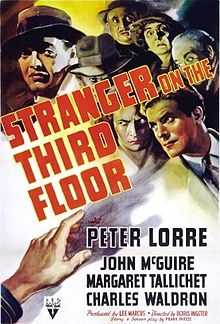Stranger on the Third Floor
| Stranger on the Third Floor | |
|---|---|
 Theatrical release poster | |
| Directed by | Boris Ingster |
| Produced by | Lee S. Marcus |
| Screenplay by |
Frank Partos Nathanael West |
| Story by |
Frank Partos Nathanael West |
| Starring |
Peter Lorre John McGuire Margaret Tallichet Elisha Cook Jr. |
| Music by | Roy Webb |
| Cinematography | Nicholas Musuraca |
| Edited by | Harry Marker |
| Distributed by | RKO Pictures |
Release dates |
|
Running time | 64 minutes |
| Country | United States |
| Language | English |
| Budget | $171,200 (estimated) |
Stranger on the Third Floor is a 1940 film noir, starring Peter Lorre and released by RKO Radio Pictures. The film was directed by Boris Ingster and co-written by Nathaniel West.[1]
Stranger on the Third Floor is often cited as the first "true" film noir of the classic period (1940–1959).[2][3][4] But it was released August 16, 1940, which was after both Rebecca and They Drive by Night.[5] Nonetheless, it has many of the hallmarks of noir: an urban setting, heavy shadows, diagonal lines, voice-over narration, a dream sequence, low camera angles shooting up multi-story staircases, and an innocent protagonist falsely accused of a crime who is desperate to clear himself.
Plot
Reporter Michael Ward is the key witness in a murder trial. His evidence – that he saw the accused Briggs standing over the body of a man in a diner – is instrumental in having Briggs found guilty.
Afterwards Ward’s fiancee Jane is worried whether Ward was correct in what he saw and Ward becomes haunted by this question. Next, Ward’s neighbour is killed the same way as the man in the diner, but Ward is arrested for trying to point this out to the police. As a result, Jane goes out to try to clear Ward by finding the sinister stranger that Ward saw on the stairwell.
Cast
- Peter Lorre as The Stranger
- John McGuire as Mike Ward
- Margaret Tallichet as Jane
- Charles Waldron as District Attorney
- Elisha Cook Jr. as Joe Briggs
- Charles Halton as Albert Meng
- Ethel Griffies as Mrs. Kane, Michael's landlady
- Cliff Clark as Martin
- Oscar O'Shea as The Judge
- Alec Craig as Briggs' Defense Attorney
Reception
Critical response
Upon its release in 1940, The New York Times film critic, Bosley Crowther, called the film pretentious and derivative of French and Russian films, and wrote, "John McGuire and Margaret Tallichet, as the reporter and his girl, are permitted to act half-way normal, it is true. But in every other respect, including Peter Lorre's brief role as the whack, it is utterly wild. The notion seems to have been that the way to put a psychological melodrama across is to pile on the sound effects and trick up the photography."[6]
The staff at Variety also believed the film was derivative, and wrote, "The familiar artifice of placing the scribe in parallel plight, with the newspaperman arrested for two slayings and only clearing himself because of his sweetheart's persistent search for the real slayer, is used...Boris Ingster's direction is too studied and when original, lacks the flare to hold attention. It's a film too arty for average audiences, and too humdrum for others."[7]
Dave Kehr, writing for the Chicago Reader, calls the film "An RKO B-film from 1940, done up in high Hollywood expressionism. It's absurdly overwrought (which was often the problem with the German variety), but interesting for it. The director, Boris Ingster, is better with shadows than with actors—venetian blinds carve up the characters with more fateful force than Paul Schrader's similar gambit in American Gigolo, and there's a dream sequence that has to be seen to be disbelieved."[8]
Currently, the film has an 80% "Fresh" rating at Rotten Tomatoes, based on five professional reviews.[9]
References
Notes
- ↑ Stranger on the Third Floor at the Internet Movie Database.
- ↑ See, e.g., Lyons (2000), p. 36 ("RKO is usually cited as having produced the first true film noir, Stranger on the Third Floor"); Server (1998), p. 158 ("Often credited as the 'first' film noir")
- ↑ Silver, Alain, and Elizabeth Ward, eds. Film Noir: An Encyclopedic Reference to the American Style, film noir review and analysis by Bob Porfiero, page 269, 3rd edition, 1992. Woodstock, New York: The Overlook Press. ISBN 0-87951-479-5.
- ↑ Selby, Spencer. Dark City: The Film Noir. Film listed as: "often referred to as the first true and total film noir," #398 on page 183, 1984. Jefferson, N.C. & London: McFarland Publishing. ISBN 0-89950-103-6.
- ↑ Stranger on the Third Floor at the Internet Movie Database
- ↑ Crowther, Bosley. The New York Times, film review, September 2, 1940. Last accessed: December 29, 2007. Last accessed: February 21, 2008.
- ↑ Variety. Film review, 1940. Last accessed: February 21, 2008.
- ↑ Kehr, Dave. Chicago Reader, film review, 1996.
- ↑ Stranger on the Third Floor at Rotten Tomatoes. Last accessed: December 29, 2007.
Additional references
- Lyons, Arthur (2000). Death on the Cheap: The Lost B Movies of Film Noir. New York: Da Capo. ISBN 0-306-80996-6
- Server, Lee (1998). "The Black List: Essential Film Noir" in The Big Book of Noir, ed. Ed Gorman, Lee Server, and Martin H. Greenberg. New York: Carroll & Graf. ISBN 0-7867-0574-4